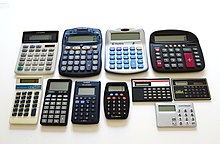Office machine
In business and administration, office machines are all tools or machines that are used as work equipment in offices .
General
In addition to office furniture, office machines are the most important components of an office, business premises or workplaces . The use of office machines should make work easier and increase the quality and volume of work . Here, a determined work analysis , the individual operations which office equipment at the workplace are required. Office machines are to be kept in an inventory that records the workplace as well as their maintenance or repair .
history
The first calculating machine ( Latin calculator ) was the abacus , which was made between around 2700 and 2300 BC. Appeared at the Sumerians . In 1642 Blaise Pascal developed a calculating machine made of wheels and cogs. Improvements were made by Gottfried Wilhelm Leibniz (1679), Willgodt Theophil Odhner (1875), Dorr Eugene Felt (1884) and Jay R. Monroe (1912).
The history of the development of the typewriter began in 1714 . That year Henry Mill patented a machine that could write words "as if in print". Friedrich von Knauss manufactured several pantographs (writing instruments) in October 1760 , the Swiss watchmaker Pierre Jaquet-Droz introduced an android in 1774 . The mechanic Wolfgang von Kempelen designed a typewriter for the blind in 1779. In 1864, the real inventor of the typewriter, Peter Mitterhofer , built a machine that used pinpoints to create perforated letters in paper. He had his first typewriter manufactured in the factory as early as 1865, and the keyboard has been standardized since 1888 .
For the American census in 1890, Herman Hollerith developed counting and sorting machines. Information was read in from punch cards, arranged, sorted and output. The office machine mechanic was responsible for the technical care and maintenance (with oil can and appropriate training) of the machine constructed by the engineers . Christopher Latham Sholes developed the first typewriter with a keyboard as the forerunner of today's typewriter, and it came onto the market in November 1872. Friedrich Soennecken invented the first mechanical and portable paper punch in 1886. On November 14th, 1886 the Imperial Patent Office granted him the patent DRP 40065 for a paper hole punch for folders, letter folders and the like. the like
In 1923 Burroughs brought out the first multiplication invoicing machine, and in 1948 the electromechanical, punched card-controlled calculating machine was introduced. The personal computer gradually moved into offices from April 1976 and not only made typewriters and calculating machines largely superfluous, but also made calendars , scheduling and time management easier .
species
Office machines include letter openers , booking machines , dictation machines , printers , teleprinters , conveyor belts , photocopiers , postage meters , hole punches , cell phones , personal computers , calculators , cash registers , pneumatic post , typewriters , fax machines , telephones , conference call systems and desktop computers . Office supplies such as files and pens are not considered office machines .
Accounting
Office machines are part of the operating and office equipment . With the exception of low-value assets , office machines are to be capitalized on the balance sheet . Corresponding balance sheet item is the operating and office equipment according to Section 266 (2) lit. A II 3 HGB . The wear and tear of the office machines is to be recorded by depreciation . Straight-line depreciation, which is to be evenly distributed over the useful life and appears in the income statement in accordance with Section 275 (2) No. 7 of the German Commercial Code , is usually suitable for this .
insurance
The business contents insurance covers damage to the inventory, including on office furniture, against the usual risks.
literature
- Literature about office machines in the catalog of the German National Library
Individual evidence
- ^ Karl Bott, Das deutsche Kaufmannsbuch , 1953, p. 504
- ^ Karl Bott, Das deutsche Kaufmannsbuch , 1953, p. 505
- ^ Conrad Matschoss , Contributions to the history of technology and industry: Yearbook of the Association of German Engineers , Volume 16, 1926, p. 258
- ^ Patent Office, Reference index of patents of invention from 1617 to 1852 , 1855, p. 49
- ↑ Herbert Bruderer, Milestones in Computing Technology , 2018, p. 100
- ↑ Patrick Robertson, What was the first time and when? , 1977, p. 207 f.
- ^ Xaver Frühbeis: Birthday of the punch (11/14/1886). ( Memento from September 2, 2004 in the Internet Archive ) In: Kalenderblatt , Bayern2 , November 14, 2000, ( RTF file, 8 kB).
- ^ Imperial Patent Office: Patent No. 40065. In: espacenet.com / European Patent Office
- ^ Tilman Driessen, Von Hollerith zu IBM , 1987, p. 33
- ↑ Reinhold Sellien / Helmut Sellien, Dr. Gabler's Wirtschafts-Lexikon , Volume 1, 1988, Sp. 1033
- ↑ Verlag Dr. Th. Gabler GmbH (Ed.), Bank-Lexikon: Concise dictionary for banking and savings banks , 1978, Sp. 287
